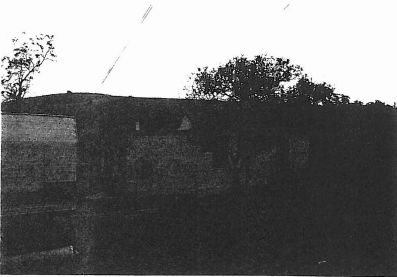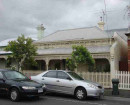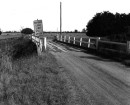705 Bacchus Marsh Road, Merrimu (Former W Symington House and Symington's Brewery Industrial Archaeological Site) 1862
Western Highway HOPETOUN PARK, MOORABOOL SHIRE
-
Add to tour
You must log in to do that.
-
Share
-
Shortlist place
You must log in to do that.
- Download report


Statement of Significance
What is significant?
The former Symington House and Brewery at 705 Bacchus Marsh Road, Bacchus Marsh.
How is it significant?
The former Symington House and Brewery at 705 Bacchus Marsh Road, Bacchus Marsh is of local historical and aesthetic significance to the Shire of Moorabool.
Why is it significant?
The former Symington House and Brewery at 705 Bacchus Marsh Road, Bacchus Marsh is of local historical significance for its association with the early settlement and development of industry in the area. The house and brewery buildings built by local figure William Symington in c. 1858-62 are the representative embodiment of the industrial process of brewing. The surviving brewery elements are of significance for their potential to yield important archaeological information. The site is also of historical significance for its associations with William Symington, a local pioneer.
The former Symington House and Brewery at 705 Bacchus Marsh Road, Bacchus Marsh is of local aesthetic significance as a representative and early surviving example of pioneer settler's residence and associated brewery. The remains of the brewery include two chimneys, a malt house and half cellar/store. These remains, as well as, the associated dwelling are of aesthetic significance for demonstrating the typical components of an early brewing site.
-
-
705 Bacchus Marsh Road, Merrimu (Former W Symington House and Symington's Brewery Industrial Archaeological Site) 1862 - Physical Description 1
An early brick house with a gable roof and L-shaped plan. The base and quoins at comers are expressed. It has tall diamond-plan chimneys with brick mouldings. There is a recent addition in front. Beside the highway, is a Shell service station and roadhouse. There is a brick outbuilding at rear.
The remains of Symington's Brewery are also located behind the service station adjacent to the surviving Symington house (G.R. 277940-5826080). While there are only a few ruins of the actual buildings, there appears to be a strong potential for surviving related archaeological evidence. (Refer: map)"
The surviving parts of the brewery complex are sections of the north and west walls of the malthouse, including parts of two chimneys, which are evident in the nineteenth century illustrations. The west wall stands to about one metre height, over a length of about three metres, although footings can be discerned for a further three metres. This appears to be partly a retaining wall against the hillside, and has been buttressed on the outside . The north wall has been reconstructed with concrete and in the north-west corner of the building, are the remains of the chimneys, with a cylindrical recess, possibly for a small boiler or copper at the base of the smaller of the two chimneys which is skewed at a 45° to the building.Immediately south of this is the larger chimney, of which only two sides stand, to about one metre. There is some concrete infil between the two chimneys.
The south end of the building has been completely demolished but brickwork appears to define the floor area of the building, with two steps at 45° dropping down to a lower level. Early illustrations show this structure as having a brick lower section and possibly a brick furnace room at the north end, with the main malting floor constructed over this in timber, with full-width opening panels in the walls and louvred lantern vents on the shingle-covered gable-roof It is understood that there was some form of root; but probably not the original upper level, over this area until about twelve months ago.
North of the malthouse remains is an excavated area which was probably a half cellar or store. Remnants of a timber retaining wall are along the west and north walls against the hill side which is excavated to a depth of2 to 3 metres. The front, or south wall survives only as a short section of I metre high brick wall attached to the back of the malthouse. This is at an angle of about 30 degrees off the alignment of the malthouse, corresponding with the building depicted in the nineteenth century illustration.
The ground surface is generally earth, but this appears to be a result of soil washing down from the hill behind and covering brick paving, which is evident to the south of the area. A number of other buildings existed on the brewery site. The main brew-house was evidently along the road frontage, about where the present service station office and shop is located. Another small house was located to the east, in the area of the present car-park.
705 Bacchus Marsh Road, Merrimu (Former W Symington House and Symington's Brewery Industrial Archaeological Site) 1862 - Physical Conditions
CONDITIONS & THREATS:
The house. Reasonable. Traffic and potential Redevelopment ofthe site threaten.
705 Bacchus Marsh Road, Merrimu (Former W Symington House and Symington's Brewery Industrial Archaeological Site) 1862 - Intactness
The house. Visibly fair, but the entire front is obscured by the addition.
All masonry is painted gloss white. Windows have been inserted
705 Bacchus Marsh Road, Merrimu (Former W Symington House and Symington's Brewery Industrial Archaeological Site) 1862 - Historical Australian Themes
Townships,
Heritage Study and Grading
Moorabool - Bacchus Marsh Heritage Study 1995
Author: Richard Peterson and Daniel Catrice
Year: 1995
Grading:
-
-
-
-
-
FORMER LEAHY'S RESIDENCE
 Victorian Heritage Register H0907
Victorian Heritage Register H0907 -
HOPETOUN CEMETERY
 Victorian Heritage Register H2059
Victorian Heritage Register H2059 -
HOPETOUN CEMETERY AND CHAPEL
 Victorian Heritage Inventory
Victorian Heritage Inventory
-
'Altona' Homestead (Formerly 'Laverton' Homestead) and Logan Reserve
 Hobsons Bay City
Hobsons Bay City
-
-











